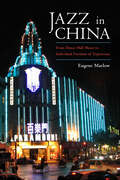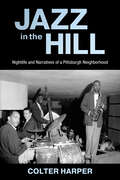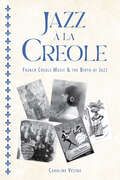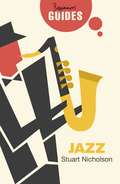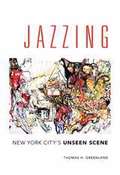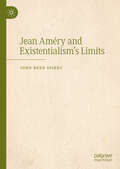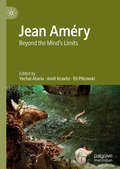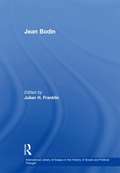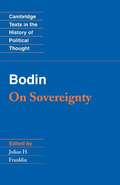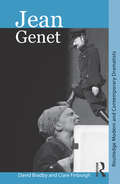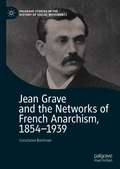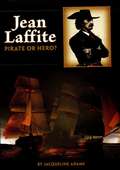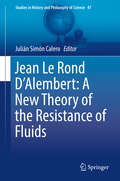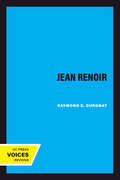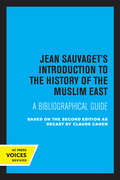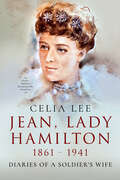- Table View
- List View
Jazz from Detroit
by Mark StrykerJazz from Detroit explores the city’s pivotal role in shaping the course of modern and contemporary jazz. With more than two dozen in-depth profiles of remarkable Detroit-bred musicians, complemented by a generous selection of photographs, Mark Stryker makes Detroit jazz come alive as he draws out significant connections between the players, eras, styles, and Detroit’s distinctive history. Stryker’s story starts in the 1940s and ’50s, when the auto industry created a thriving black working and middle class in Detroit that supported a vibrant nightlife, and exceptional public school music programs and mentors in the community like pianist Barry Harris transformed the city into a jazz juggernaut. This golden age nurtured many legendary musicians—Hank, Thad, and Elvin Jones, Gerald Wilson, Milt Jackson, Yusef Lateef, Donald Byrd, Tommy Flanagan, Kenny Burrell, Ron Carter, Joe Henderson, and others. As the city’s fortunes change, Stryker turns his spotlight toward often overlooked but prescient musician-run cooperatives and self-determination groups of the 1960s and ’70s, such as the Strata Corporation and Tribe. In more recent decades, the city’s culture of mentorship, embodied by trumpeter and teacher Marcus Belgrave, ensured that Detroit continued to incubate world-class talent; Belgrave protégés like Geri Allen, Kenny Garrett, Robert Hurst, Regina Carter, Gerald Cleaver, and Karriem Riggins helped define contemporary jazz. The resilience of Detroit’s jazz tradition provides a powerful symbol of the city’s lasting cultural influence. Stryker’s 21 years as an arts reporter and critic at the Detroit Free Press are evident in his vivid storytelling and insightful criticism. Jazz from Detroit will appeal to jazz aficionados, casual fans, and anyone interested in the vibrant and complex history of cultural life in Detroit.
Jazz in China: From Dance Hall Music to Individual Freedom of Expression
by Eugene MarlowFinalist for the 2019 Jazz Journalists Association Book of the Year About Jazz, Jazz Awards for Journalism"Is there jazz in China?" This is the question that sent author Eugene Marlow on his quest to uncover the history of jazz in China. Marlow traces China's introduction to jazz in the early 1920s, its interruption by Chinese leadership under Mao in 1949, and its rejuvenation in the early 1980s with the start of China's opening to the world under Premier Deng Xiaoping.Covering a span of almost one hundred years, Marlow focuses on a variety of subjects--the musicians who initiated jazz performances in China, the means by which jazz was incorporated into Chinese culture, and the musicians and venues that now present jazz performances.Featuring unique, face-to-face interviews with leading indigenous jazz musicians in Beijing and Shanghai, plus interviews with club owners, promoters, expatriates, and even diplomats, Marlow marks the evolution of jazz in China as it parallels China's social, economic, and political evolution through the twentieth and into the twenty-first century. Also featured is an interview with one of the extant members of the Jimmy King Big Band of the 1940s, one of the first major all-Chinese jazz big bands in Shanghai.Ultimately, Jazz in China: From Dance Hall Music to Individual Freedom of Expression is a cultural history that reveals the inexorable evolution of a democratic form of music in a Communist state.
Jazz in the Hill: Nightlife and Narratives of a Pittsburgh Neighborhood (American Made Music Series)
by Colter HarperFrom the 1920s through the 1960s, Pittsburgh’s Hill District was the heart of the city’s Black cultural life and home to a vibrant jazz scene. In Jazz in the Hill: Nightlife and Narratives of a Pittsburgh Neighborhood, Colter Harper looks at how jazz shaped the neighborhood and created a way of life. Beyond backdrops for remarkable careers, jazz clubs sparked the development of a self-determined African American community. In delving into the history of entrepreneurialism, placemaking, labor organizing, and critical listening in the Hill District, Harper forges connections to larger political contexts, processes of urban development, and civil rights struggles.Harper adopts a broad approach in thinking about jazz clubs, foregrounding the network of patrons, business owners, and musicians who were actively invested in community building. Jazz in the Hill provides a valuable case study detailing the intersections of music, political and cultural history, public policy, labor, and law. The book addresses distinctive eras and issues of twentieth century American urban history, including notions of “vice” during the Prohibition Era (1920–1934); “blight” during the mid-twentieth century boom in urban redevelopment (1946–1973); and workplace integration during the civil rights era (1954–1968). Throughout, Harper demonstrates how the clubs, as a nexus of music, politics, economy, labor, and social relations, supported the livelihood of residents and artists while developing cultures of listening and learning. Though the neighborhood has undergone an extensive socioeconomic transformation that has muted its nightlife, this musical legacy continues to guide current development visions for the Hill on the cusp of its remaking.
Jazz à la Creole: French Creole Music and the Birth of Jazz (American Made Music Series)
by Caroline VézinaWinner of the 2023 Award for Excellence for Best Historical Research in Recorded Jazz from the Association for Recorded Sound CollectionsDuring the formative years of jazz (1890–1917), the Creoles of Color—as they were then called—played a significant role in the development of jazz as teachers, bandleaders, instrumentalists, singers, and composers. Indeed, music penetrated all aspects of the life of this tight-knit community, proud of its French heritage and language. They played and/or sang classical, military, and dance music as well as popular songs and cantiques that incorporated African, European, and Caribbean elements decades before early jazz appeared. In Jazz à la Creole: French Creole Music and the Birth of Jazz, the author describes the music played by the Afro-Creole community since the arrival of enslaved Africans in La Louisiane, then a French colony, at the beginning of the eighteenth century, emphasizing the many cultural exchanges that led to the development of jazz. Caroline Vézina has compiled and analyzed a broad scope of primary sources found in diverse locations from New Orleans to Quebec City, Washington, DC, New York City, and Chicago. Two previously unpublished interviews add valuable insider knowledge about the music on French plantations and the danses Créoles held in Congo Square after the Civil War. Musical and textual analyses of cantiques provide new information about the process of their appropriation by the Creole Catholics as the French counterpart of the Negro spirituals. Finally, a closer look at their musical practices indicates that the Creoles sang and improvised music and/or lyrics of Creole songs, and that some were part of their professional repertoire. As such, they belong to the Black American and the Franco-American folk music traditions that reflect the rich cultural heritage of Louisiana.
Jazz: A Beginner's Guide (Beginner's Guides)
by Stuart NicholsonThis definitive guide includes a unique chapter-by-chapter playlist for the reader. Jazz: A Beginner&’s Guide is a lively and highly accessible introduction to a global musical phenomenon. Award-winning music journalist and author Stuart Nicholson takes the reader on an entertaining journey from jazz's early stirrings in America&’s south through to the present day, when almost every country in the world has its own vibrant jazz scene.En route we meet a host of jazz heroes past and present, from Louis Armstrong, Benny Goodman and Miles Davis, to Keith Jarrett and Kamasi Washington. Each chapter is accompanied by a playlist designed to provide a stimulating and enjoyable entry point to what has been described as the most exciting art form of all.
Jazzing: New York City's Unseen Scene
by Thomas H. GreenlandHow do we speak about jazz? In this provocative study based on the author's deep immersion in the New York City jazz scene, Tom Greenland turns from the usual emphasis on artists and their music to focus on non-performing participants, describing them as active performers in their own right who witness and thus collaborate in a happening made one-of-a-kind by improvisation, mood, and moment. Jazzing shines a spotlight on the constituency of proprietors, booking agents, photographers, critics, publicists, painters, amateur musicians, fans, friends, and tourists that makes up New York City's contemporary jazz scene. Drawn from deep ethnographic research, interviews, and long term participant observation, Jazzing charts the ways New York's distinctive physical and social-cultural environment affects and is affected by jazz. Throughout, Greenland offers a passionate argument in favor of a radically inclusive conception of music-making, one in which individuals collectively improvise across social contexts to co-create community and musical meaning. An odyssey through the clubs and other performance spaces on and off the beaten track, Jazzing is an insider's view of a vibrant urban art world.
Jazzocracy: Jazz, Democracy, and the Creation of a New American Mythology
by Kabir SehgalSehgal explores the nature of jazz as it relates to the liberty and freedoms of a democratic nation.
Jean Améry and Existentialism’s Limits
by John Reed SpiersThis book provides an in-depth analysis of the influences and impact of philosopher, writer and public intellectual, Jean Améry. Améry&’s writing is often analysed in terms of his experiences as a Jew in Austria during WWII which saw him stripped of his identity, driven into exile, and dehumanised in torture and the death camps. Despite the increasing interest in the philosophical, ethical, and literary dimensions of Améry&’s thought, little research discusses his relationship with the most important intellectual discovery of his life: existentialism. This book contributes to and expands upon recent engagements with Améry&’s work by situating him within the existential tradition and discussing his writing within the context of his peers and influences. John Reed Spiers argues that reading Améry in the context of the existential tradition contributes to a greater appreciation of his importance as a writer reflecting on the human condition, broadening the Anglophone reception of his work beyond Holocaust Studies, trauma studies, and victimology.
Jean Améry: Beyond the Mind's Limits
by Yochai Ataria Amit Kravitz Eli PitcovskiThis volume explores themes originating from the work of Jean Améry (1912–1978), a Holocaust survivor and essayist—mainly, ethics and the past, torture and its implications, death and suicide. The volume is interdisciplinary, bringing together contributions from philosophy, psychology, law, and literary studies to illuminate each of the topics from more than one angle. Each essay is a novel contribution, shedding new light on the relevant subject matter and on Jean Améry's unique perspective. The ensuing picture is rich and multifaceted, uncovering unforeseen traits of Amery's thought, and surprising correlations that have so far been under-researched. It invites further studies of the Holocaust and its consequences to take their cue from non-neutral first person reflections.
Jean Bodin (International Library Of Essays In The History Of Social And Political Thought Ser.)
by Julian H. FranklinIn the course of a lifetime, Jean Bodin aimed at nothing less than to encompass all the disciplines of his age in a huge encyclopedia of knowledge. In many areas, his ideas have been not only original but seminal. He made major contributions to historiography, philosophy of history, economics, political science, comparative public law and policy, religion and national philosophy. This volume brings together a selection of major articles in English, representing almost all of his intellectual interests. It is an essential collection for libraries and scholars in both humanities and social sciences.
Jean Bodin: Four chapters from The Six Books of the Commonwealth
by Jean Bodin Julian H. FranklinThis volume contains the essential points of Jean Bodin's theory of sovereignty, a landmark in legal theory and royalist ideology.
Jean Genet: Performance And Politics (Routledge Modern and Contemporary Dramatists)
by David Bradby Claire FinburghThis book is the only introductory text to Genet in English, offering an overview of this key figure in defining and understanding twentieth-century theatre. The authors provide a comprehensive account of Genet's key plays and productions, his early life and his writing for and beyond the theatre.
Jean Gerson and Gender
by Nancy McloughlinJean Gerson and Gender reconciles the somewhat enigmatic legacy of one of the most influential late medieval intellectuals: the theologian, court preacher, university chancellor, and church reformer, Jean Gerson (d. 1429). Gerson provided foundational contributions to two historical developments: the promotion of rational and just government, and the development of the European concept of the witch. This book argues that Gerson's association of royal and ascetic women with sin and diabolical influences allowed him to maintain - against overwhelming evidence to the contrary – the appearance of centralized monarchical rule, a stable ecclesiastical hierarchy, and a reliable method for constructing communally verifiable political and religious truths.
Jean Grave and the Networks of French Anarchism, 1854-1939 (Palgrave Studies in the History of Social Movements)
by Constance BantmanThis biography charts the life and fascinating long militant career of the French anarchist journalist, editor, theorist, writer, campaigner and educator Jean Grave (1854-1939), from the run up to the 1871 Paris Commune to the eve of the Second World War. Through Grave, it explores the history of the French and international anarchist communist movement over seven decades: its “heroic period” (1880-1890s), shaken by terrorist violence and intense repression, the emergence of syndicalism, national and international solidarity campaigns, the divisions over the First World War, and post-war division and relegation. Through Grave, a “sedentary transnationalist,” the study investigates the networked and transnational organisation of the anarchist movement, addressing the paradox of Grave’s international influence alongside his deep rootedness in Paris by emphasizing the movement’s global print culture and staggering circulations.
Jean Jaurès: The Inner Life of Social Democracy
by Geoffrey KurtzJean Jaurès was a towering intellectual and political leader of the democratic Left at the turn of the twentieth century, but he is little remembered today outside of France, and his contributions to political thought are little studied anywhere. In Jean Jaurès: The Inner Life of Social Democracy, Geoffrey Kurtz introduces Jaurès to an American audience. The parliamentary and philosophical leader of French socialism from the 1890s until his assassination in 1914, Jaurès was the only major socialist leader of his generation who was educated as a political philosopher. As he championed the reformist method that would come to be called social democracy, he sought to understand the inner life of a political tradition that accepts its own imperfection. Jaurès's call to sustain the tension between the ideal and the real resonates today.In addition to recovering the questions asked by the first generation of social democrats, Kurtz’s aim in this book is to reconstruct Jaurès’s political thought in light of current theoretical and political debates. To achieve this, he gives readings of several of Jaurès’s major writings and speeches, spanning work from his early adulthood to the final years of his life, paying attention to not just what Jaurès is saying, but how he says it.
Jean Jaurès: The Inner Life of Social Democracy
by Geoffrey KurtzJean Jaurès was a towering intellectual and political leader of the democratic Left at the turn of the twentieth century, but he is little remembered today outside of France, and his contributions to political thought are little studied anywhere. In Jean Jaurès: The Inner Life of Social Democracy, Geoffrey Kurtz introduces Jaurès to an American audience. The parliamentary and philosophical leader of French socialism from the 1890s until his assassination in 1914, Jaurès was the only major socialist leader of his generation who was educated as a political philosopher. As he championed the reformist method that would come to be called social democracy, he sought to understand the inner life of a political tradition that accepts its own imperfection. Jaurès's call to sustain the tension between the ideal and the real resonates today.In addition to recovering the questions asked by the first generation of social democrats, Kurtz’s aim in this book is to reconstruct Jaurès’s political thought in light of current theoretical and political debates. To achieve this, he gives readings of several of Jaurès’s major writings and speeches, spanning work from his early adulthood to the final years of his life, paying attention to not just what Jaurès is saying, but how he says it.
Jean Laffite: Pirate or Hero? (Fountas & Pinnell LLI Purple #Level V)
by Jacqueline AdamsPirate, smuggler, outlaw, spy. Jean Laffite (ZHAHN la-FEET) was all of these things. But he was also a hero. This legendary pirate surprised everyone by defending the United States when it was under attack. This move came as a surprise because authorities from Louisiana, which was part of the United States, wanted to arrest Jean. Many stories are told about Jean Laffite. It's impossible to tell if some are true or exaggerated. But we do know some things about his unusual and adventurous life. Here is his story.
Jean Le Rond D'Alembert: A New Theory of the Resistance of Fluids
by Julián Simón CaleroIn the commentaries to this book we try to understand d’Alembert thoughts and how he contrives to translate his ideas on mechanics to the fluid realm with a new and radical point of view; how he arrives at the first two fundamental differential equations among the velocity components; and how he tries to reduce the resistance of a moving body, which is a change of its momentum, to the hydrostatical pressure, which is related to the gravity. All this knowing that his mechanics has no forces and no pressures as well, and that the fluids are aggregates of individual particles.The essay A New Theory of the Resistance of Fluids was a turning point in Fluid Mechanics because clearly, for the first time, the resistance is shown as the results of a fluid subjected to differential equations in a continuous mode instead of a set of impacts of individual particles. This contribution has been recognized by the scholars. However, only partial attention has been paid to this work, which can be justified due to the difficulty in its reading and also because it was eclipsed by the publication, a few years later, of Euler’s three Memoirs that established modern hydrodynamics.
Jean Monnet and Canada
by Trygve UglandJean Monnet (1888-1979) is often viewed as the chief architect of the European Coal and Steel Community, which over time evolved into today's European Union. Monnet spent his early years working as an agent for his father, a cognac producer. It was this experience that took him to Scandinavia, England, the United States, and most importantly Canada, where he was exposed to the country's unique form of federalism.Drawing on a wide variety of empirical sources, including unpublished documents, correspondence, and original historical data extracted from archives both in Canada and Europe, Trygve Ugland's Jean Monnet and Canada argues that the extensive period of time Monnet spent in Canada between 1907 and 1914 had a formative influence on the achievements of his later years, particularly on the institutional 'construction of Europe.'
Jean Peters: Hollywood's Mystery Girl (Hollywood Legends Series)
by Michelangelo CapuaFrom 1947 to 1955, Jean Peters (1926–2000) appeared in films opposite such Hollywood leading men as Tyrone Power, Marlon Brando, Burt Lancaster, Spencer Tracy, Richard Widmark, and Robert Wagner, as well as international stars including Louis Jourdan and Rossano Brazzi. Despite her talent and status, Peters eschewed the star-studded lifestyle of 1950s Hollywood, turning down roles that were “too sexy” and refusing to socialize with other actors, discuss her private life in the press, or lead the glamorous lifestyle often associated with her peers. She was seen as a mystery to reporters, who constantly tried to discover tidbits about her personal life.In 1957, her marriage to Howard Hughes led to her retirement from acting and her further withdrawal from social events in Hollywood. Instead, she shifted her attention to charitable work, arts and crafts, and university studies in psychology and anthropology. Her status as an enigma only grew as she agreed never to speak of her marriage with Hughes. After her divorce, however, Peters attempted to resume her acting career in television but never regained her previous level of stardom. Jean Peters: Hollywood's Mystery Girl grants an in-depth analysis of each of her nineteen films and is enriched by several high-quality photographs from the author’s personal collection.
Jean Renoir
by Raymond E. DurgnatThis title is part of UC Press's Voices Revived program, which commemorates University of California Press’s mission to seek out and cultivate the brightest minds and give them voice, reach, and impact. Drawing on a backlist dating to 1893, Voices Revived makes high-quality, peer-reviewed scholarship accessible once again using print-on-demand technology. This title was originally published in 1974.This title is part of UC Press's Voices Revived program, which commemorates University of California Press’s mission to seek out and cultivate the brightest minds and give them voice, reach, and impact. Drawing on a backlist dating to 1893, Voices Revived</DIV
Jean Sauvaget's Introduction to the History of the Muslim East: A Bibliographical Guide
by Claude Cahen Jean SauvagetThis title is part of UC Press's Voices Revived program, which commemorates University of California Press’s mission to seek out and cultivate the brightest minds and give them voice, reach, and impact. Drawing on a backlist dating to 1893, Voices Revived makes high-quality, peer-reviewed scholarship accessible once again using print-on-demand technology. This title was originally published in 1965.
Jean Sibelius and His World (The Bard Music Festival #25)
by Daniel M. GrimleyNew perspectives on the greatest Finnish composer of all timePerhaps no twentieth-century composer has provoked a more varied reaction among the music-loving public than Jean Sibelius (1865–1957). Originally hailed as a new Beethoven by much of the Anglo-Saxon world, he was also widely disparaged by critics more receptive to newer trends in music. At the height of his popular appeal, he was revered as the embodiment of Finnish nationalism and the apostle of a new musical naturalism. Yet he seemingly chose that moment to stop composing altogether, despite living for three more decades. Providing wide cultural contexts, contesting received ideas about modernism, and interrogating notions of landscape and nature, Jean Sibelius and His World sheds new light on the critical position occupied by Sibelius in the Western musical tradition.The essays in the book explore such varied themes as the impact of Russian musical traditions on Sibelius, his compositional process, Sibelius and the theater, his understanding of music as a fluid and improvised creation, his critical reception in Great Britain and America, his "late style" in the incidental music for The Tempest, and the parallel contemporary careers of Sibelius and Richard Strauss.Documents include the draft of Sibelius's 1896 lecture on folk music, selections from a roman à clef about his student circle in Berlin at the turn of the century, Theodor Adorno's brief but controversial tirade against the composer, and the newspaper debates about the Sibelius monument unveiled in Helsinki a decade after the composer's death.The contributors are Byron Adams, Leon Botstein, Philip Ross Bullock, Glenda Dawn Goss, Daniel Grimley, Jeffrey Kallberg, Tomi Mäkelä, Sarah Menin, Max Paddison, and Timo Virtanen.
Jean de Saintré
by Antoine de La SaleWritten in 1456 and purporting to be the biography of an actual fourteenth-century knight, Jean de Saintré has been called the first modern novel in French and one of the first historical novels in any language. Taken in hand at the age of thirteen by an older and much more experienced lady, Madame des Belles Cousines, the youth grows into an accomplished knight, taking the prize in numerous tournaments and even leading a crusade against the infidels for the love of Madame. When he reaches maturity, Jean starts to rebel against Madame's domination by seeking out his own chivalric adventures. She storms off to her country estates and takes up with the burly abbot of a nearby monastery. The text takes a dark and uncourtly turn when Jean discovers their liaison and lashes out to avenge his lost love and honor, ruining Madame's reputation in the process. Composed in the waning years of chivalry and at the threshold of the print revolution, Jean de Saintré incorporates disquisitions on sin and virtue, advice on hygiene and fashion, as well as lengthy set pieces of chivalric combat. Antoine de La Sale, who was, by turns, a page, a royal tutor, a soldier, and a judge at tournaments, embellished his text with wide-ranging insights into chivalric ideology, combat techniques, heraldry and warfare, and the moral training of a young knight. This superb translation--the first in nearly a hundred years--contextualizes the story with a rich introduction and a glossary and is suitable for scholars, students, and general readers alike. An encyclopedic compilation of medieval culture and a window into the lost world of chivalry, Jean de Saintré is a touchstone text for both the late Middle Ages and the emergence of the modern novel.
Jean, Lady Hamilton, 1861–1941: Diaries of A Soldier's Wife
by Celia Lee“A pleasure to read. It’s predominantly about the life of Jean Hamilton’s husband Ian as an officer during the Great War and life for both before and after.” —UK HistorianJean, Lady Hamilton’s diaries remained forgotten and hidden in the Liddell Hart Centre for Military Archives, King’s College, London, for fifty years. The story begins with the young couples’ wedding, a dazzling bride, Jean Muir, marrying a star-struck Major Ian Hamilton. The daughter of the millionaire businessman Sir John Muir, Jean had all the money whilst Hamilton was penniless.Having spent their early married years in India, the Hamiltons returned and set up house in the prestigious Hyde Park area of London, also eventually buying Lullenden Manor, East Grinstead, that they purchased as a country home from Winston Churchill when he could no longer afford it. Churchill in particular was like family in the Hamiltons’ home; he used to go there and practice his speeches, and painted alongside Jean to whom he sold his first painting.Jean chronicled Ian’s long army career that culminated in the Gallipoli campaign in 1915. The failure there ended her husband’s distinguished career and almost ended Churchill’s as he had to leave his job as First Lord of the Admiralty. This account is Lady Hamilton’s “attempt to chronicle her husband’s life as a top-flight but penniless soldier, this at a time when young Winston Churchill . . . was emerging from his own distinguished and very colourful military career to enter a life of politics . . . Jean Hamilton is one of those larger than life people of whom we know very little until a book such as Celia’s comes along” (Books Monthly).

